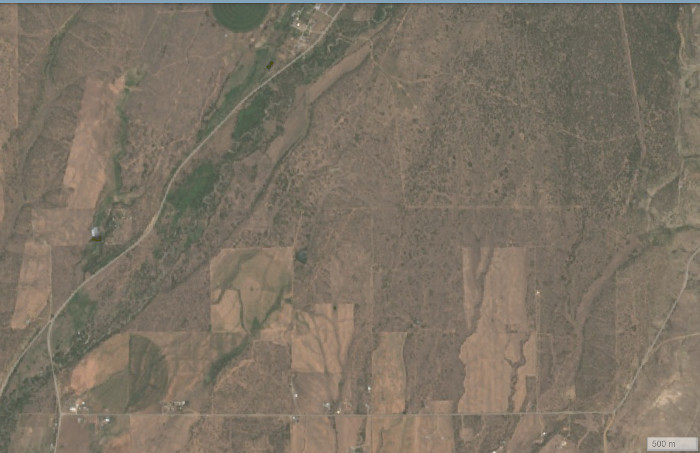
Durango Bill's
Do Not Stop Hesperus Solar
Do Not Stop Hesperus Solar
The entire argument of for vs. against the Hesperus Solar project may be mute since there is now a proposal to build a 971 MWdc solar project on 4400 acres of Ute Mountain land south of Towaoc. The proposed name for the new project (which is several times larger than the proposed Hesperus project) is Sun Bear.
Recently, Primergy has proposed to build a 155 MWac solar array project on unused land to the south of the community of Hesperus, Colorado. (Full details of Primergy's permit application can be found here. If you want to see the estimated (mostly non-existent) visual impacts on nearby public and residential property, please download and read "Appendix V - Visual Impact Assessment" from this link)
A "Stop Hesperus Solar" group of local residents has initiated a web page in an effort to block this new and less expensive source of providing local generation of electricity. For the reasons listed below, stopping this project would be detrimental to the people who live here.

The "Stop Hesperus Solar" webpage/group ( https://stophesperussolar.com/ ) lists 4 reasons why they object to the project.
1) Prolific, irreversible loss to vital wildlife habitats and one of the largest migration corridors in Colorado!If you take a close look at these "objections", they seem to be at least gross exaggerations if not outright fabrications.
2) ZERO Energy Benefits for La Plata County
3) ZERO Change to your energy bill
4) ZERO Local Job creation guaranteed
1) "Prolific, irreversible loss to vital wildlife habitats and one of the largest migration corridors in Colorado!"
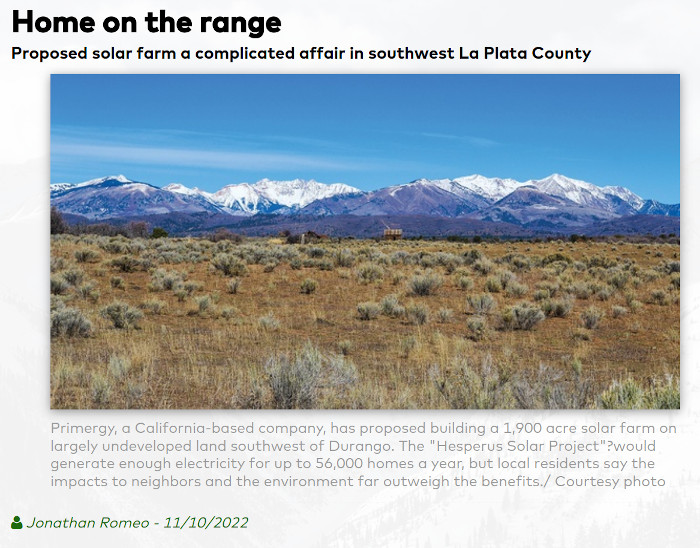
Picture courtesy of The
Durango Telegraph
The picture above depicts the "vital wildlife habitats" that will be subject to "irreversible loss". No, the scenic mountains (or the view thereof) will not be lost. The "vital wildlife habitats" will be the unused/uninhabited dry sagebrush covered flat-lands in the foreground.
As for the "irreversible loss" to "one of the largest migration corridors in Colorado", the following quote is from Primergy:
"Added an approximately 1,000 ft-wide wildlife corridor through the middle of the project."For what it's worth, the location the photograph was taken from is on land registered to "James Isgar, Trustee" just to the north of property registered to "Trapper & Bethany Niccum" (but not on the Niccums' property), and looks north toward the La Plata Mountains. Unless the photographer (and anyone who accompanied him) had prior permission from the Isgar Trustee, they were trespassing on private property without prior permission. The photograph itself has been widely used by the "Stop Hesperus Solar" website.
https://cityview.laplata.co.us/Planning/GetFile/211160
2) "ZERO Energy Benefits for La Plata County."
(Click on picture for a large version)
The Electric Transmission Lines map above is courtesy of link The map shows the principal electric transmission lines in the southwestern U. S. as of 2017. Higher capacity lines are color coded while smaller lines are in black. There are only two lines feeding into Durango. (And this source continues eastward and is the only source to Bayfield and Pagosa Springs.) The closest feed-in to Durango comes from the Hesperus electrical substation. The other line (which can serve as a back-up line) comes in from the Lost Canyon electrical substation further away and near Dolores.
It costs money to send electricity over long distance transmission lines. There are electrical losses along the way. (Please see How do Electric Transmission Lines Work? ) It makes economic sense to sell your electricity production to customers that are as close as possible to your production facilities. On top of that "On average the levelized cost of electricity from utility scale solar power and onshore wind power is less than from coal and gas-fired power stations". Wikipedia
The optimal economic market for the proposed Hesperus Solar project is to feed the produced electricity into the Hesperus substation (which is what Primergy intends to do) and supply low cost electricity to "56,000 homes" in Durango, Bayfield, and Pagosa Springs.
"Project Highlights"
A quote from Primergy
"Hesperus will provide energy to around 56,000 homes annually in Western Colorado and Northern New Mexico. Hesperus will create more than 350 construction and permanent jobs as well as provide additional economic benefits to the area"
3) "ZERO Change to your energy bill"
"Healthy Market Competition is fundamental to a well-functioning U. S. economy. Basic economic theory demonstrates that when firms have to compete for customers, it leads to lower prices, higher quality goods and services, greater variety, and more innovation" link
Kit Carson Electric is an example of what can happen if your local electricity comes from solar. Kit Carson Electric (a coop similar to LPEA) was one of the cooperatives that had been under Tri-State's burdening yoke of coal based power. With the help of Guzman Energy (Primergy's partner in the Hesperus Solar Project), Kit Carson was able to break free of Tri-State. (Tri-State is still LPEA's source of electricity.) Kit Carson's electric rates are now 33% lower than LPEA's. Story at Kit Carson Electric.
4) "ZERO Local Job creation guaranteed"
Once again - "Healthy Market Competition is fundamental to a well-functioning U. S. economy. Basic economic theory demonstrates that when firms have to compete for customers, it leads to lower prices, higher quality goods and services, greater variety, and more innovation" link
Also for 3) and 4): Competition Counts - "How Consumers win when businesses compete" (by the U. S. Federal Trade Commission )
Our economy requires electricity. Without low cost electricity, we freeze in the dark.
Lower cost electricity makes it easier for people to open and run new businesses and services. It's just elementary economics that this is where the new jobs will be.
Other benefits of the
proposed Hesperus solar project.
The "Stop Hesperus Solar" webpage doesn't mention taxes. The Hesperus Solar Project will pay millions of dollars in taxes. Every dollar that Primergy pays in taxes is money that individual tax payers don't have to pay.
Finally, there is the possibility that Putin (or his successors) will have a "bad hair day" and start a nuclear war. Durango is a small town and it is extremely unlikely to be a target, but you can assume that the large electrical generating plants and the electrical grid would be. (Just ask the Ukrainians.) Given that solar farms are widely scattered, it is unlikely that they would be targeted. If we generate electricity locally, in all probability, the local Durango area would not be freezing in the dark.
The practical value of having a backup local source of electricity should not be ignored - by society in general or in particular by local government/civil authorities. In Feb. 2021 large parts of Texas ended up freezing in the dark for days after the "grid went down". For documentation of this or possibly worse (even without a nuclear "assist" by Russia or China) please see "How Long Would Society Last During a Total Grid Collapse" (Video by Practical Engineering).
"Electricity is not just a luxury. It is a necessity of modern life"
Conversely, Hurricane Ian devastated Fort Myers Florida in late Sept. 2022, but the residents of the "Babcock Ranch" subdivision on the northeast side of Fort Myers escaped without loosing electricity. How and why? Here's a hint. The Babcock Ranch subdivision calls itself "America's first solar-powered town." (Video via CBS News)
"The storm obliterated the nearby Fort Myers and Naples areas with record-breaking surge and winds over 100 mph. It knocked out power to more than 2.6 million customers in the state, including 90% of Charlotte County.
But the lights stayed on in Babcock Ranch."
Finally, we should listen to what the landowners of the Hesperus solar project have to say. All three landowners have been long-time stewards of their portion of the proposed project, and presumably have a common sense feeling for what is the best usage of their land.
1) Joan Kellogg, the sister of the late senator (Isgar property): “Above all, I know my brother would look at farming the sun as he would any other crop – something to be harvested responsibly, and another way to make a living in an era when family farms and ranches nationwide must work hard to stay afloat.”
2) Sherry Wertz (One of the owners of Three Sisters LLC): “I just did what I had to do as far as selling the property,” she said. “They gave me what I asked.”
3) Beth LaShell, the director of the Old Fort at Hesperus (Fort Lewis College manages the Colorado State Land Board portion): “I think it’s important to our students,” she said. “We’re very a student-centered college. (Solar) is important to our students, they’re interested in it, they ask questions about it, we’re trying to teach classes on it and this gives them the opportunity to have some unique internships.”
False information
by the "Stop Hesperus Solar" Obstructionists
by the "Stop Hesperus Solar" Obstructionists
It appears that the "Stop Hesperus Solar" obstructionists are quite willing to publish false information in their efforts to stop the proposed solar project. In an effort to make the land involved look like it is productive for other purposes, the obstructionists submitted the following letter to "The Journal".
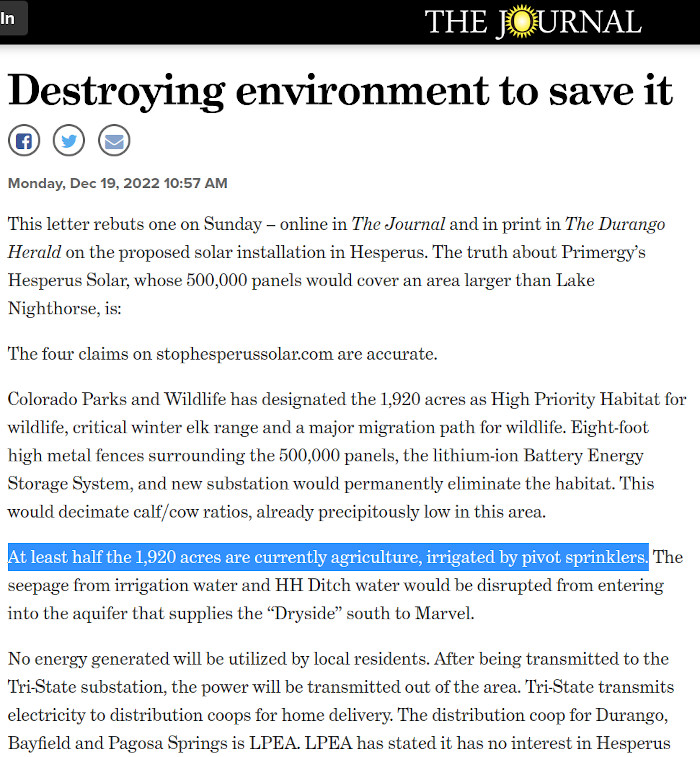
Please note the statement: "At least half the 1,920 acres are currently agriculture, irrigated by pivot sprinklers."
So let's look at a satellite photograph of the 1,920 acres plus a little of the adjacent land that contains identifiable landmarks.
(Click on image for a large version}
The above photograph is a satellite view of the solar project area. The posted date for the photograph is July 8, 2022. The view can be seen by going to Sentinel Playground , clicking on "Open Sentinel Playground", scrolling and zooming to southwestern Colorado, and selecting July 8, 2022 via the calendar icon.
Part of the small community of Breen is visible in the lower left corner. Highway 140 enters from near the center of the top edge and continues off the bottom edge near the lower left corner. Highway 141 enters from near the center of the right edge and slants southwestward to near the bottom edge. Highway 141 then turns due west to join Highway 140 at the community of Breen. The proposed Primergy Solar Project is within these boundaries. (Also please see the illustration below.)
There is one obvious center pivot irrigation system that is currently being used that is visible near the lower left corner. This pivot irrigation system is outside the proposed solar system (see below). If you look closely you can see the faint outline of another circular pivot system to the left of and below the center of the photograph. If this were currently being used, you would see dark vegetated sectors inside the old circle rim. However the only dark vegetated areas in this circle are in natural drainage areas. It appears that this pivot irrigation system is not currently being used.
Other than the above pivot systems, there are NO other visible center pivot irrigation systems in the proposed area for the Hesperus Solar Project. But as noted above, this visual evidence is ignored by the obstructionists who claim "At least half the 1,920 acres are currently agriculture, irrigated by pivot sprinklers."
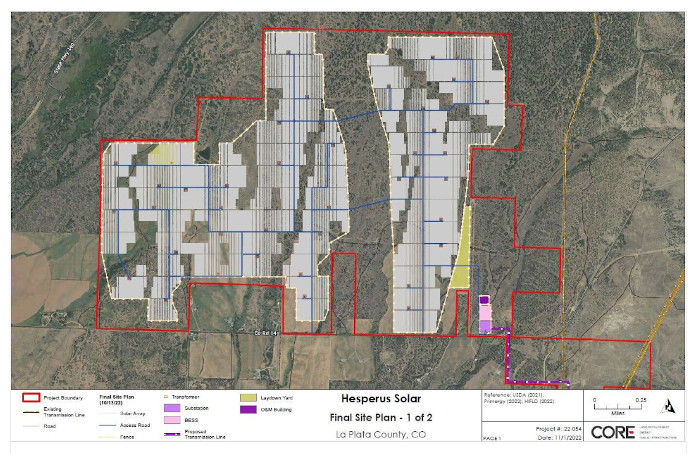
The picture above was printed in the Dec. 17. 2022 issue of the Durango Herald. The original picture was supplied by Primergy. The area covered by the picture is similar to the Sentinel Playground photograph shown earlier. A small section of Highway 140 is visible in the upper left corner, and Highway 141 enters from the right edge and continues west just above the bottom edge.
The red polygon surrounding the center half of the diagram encloses the acreage that Primergy proposes to buy and lease for their solar system. (Buy most of the right half of the enclosed area (the Three Sisters property) and pay rent (via long term leases) for the rest of the area.) The light shading represents the currently estimated positions of the proposed solar panels.
The currently used pivot irrigation system is again visible on the extreme left edge. It is not covered by the proposed array of solar panels. Except for the not currently used pivot system there are NO center pivot irrigation systems that would be covered by the proposed panels.
Yet the obstructionists
claim:
"At least half the 1,920
acres are currently agriculture,
irrigated by pivot sprinklers."
irrigated by pivot sprinklers."
The land involved, while essentially unused, is registered with the county as "agricultural land" as opposed "vacant land". In La Plata County "agricultural land" is taxed at a much lower rate than "vacant land" which is taxed at a much higher rate.
718 acres of the proposed solar farm had been registered to "Three Sisters Durango LLC" (the Sherry Wertz property), with a taxable "Land value" (assessor valuation) of $48,170 because it is "agricultural land". (Of course you have to do something to make it "look" like a farm. For example, put a few farm animals on it.) If the land was listed as "vacant", the taxable "Land value" (assessor valuation) would be based on the free market price of the property. The property had been listed as "for sale" with real estate agents for $2,750,000. (MLS # 762229). (Hesperus Solar actually paid $2,900,000 for the property.)


A recent article in the Durango Herald said "The Wertz property has . . . about a dozen cattle but no other agricultural outputs." Would anyone like to put these pieces of information together?
Let's take a look at the complete version of that last paragraph.

Please note the statement "LPEA has stated it has no interest in Hesperus Solar."
In regard to the obstructionists' claim that "LPEA has stated it has no interest in Hesperus Solar". Here's part of what LPEA actually said and a link to where they said it. (Note: LPEA is aware of what the obstructionists had falsely claimed and has issued an updated statement ( at link ) that refutes these not-factual claims.)
"If the project proceeds and results in the generation of cost-competitive power, LPEA may be able to purchase power from the development in the future, but it is too early to judge the feasibility of that option."
Here is a published quote from LPEA's CEO as published on June 8, 2022 at the Utility Dive.
The following is a contributed article by Jessica Matlock, CEO of La Plata Electric Association, Jeff Wadsworth, CEO of Poudre Valley Rural Electric Association, and Brad Zaporski, CEO of San Miguel Power Association
Much is written and said about the “clean energy transition.” While it looks a little bit different for every utility, at its core the transition is about finding a flexible, reliable power supply that takes advantage of local clean energy sources, manages rates, and ensures a sustainable future.Does "finding a flexible, reliable power supply that takes advantage of local clean energy sources" by LPEA's CEO sound like "LPEA has stated it has no interest in Hesperus Solar"?
It's a reasonable assumption that Jessica Matlock was well aware of the proposed Hesperus Solar project when she made this statement. Large projects such as the proposed Hesperus Solar project require years of advance planning, and Primergy had signed a Power Purchase Agreement with Denver based Guzman Energy some 13 months earlier.
Here's a quote from the Durango Herald when reporter Reuben Schafir was interviewing Kathryn Meyer, the director of development for Primergy Solar.
The energy created from the solar array will be sold to a local entity or utility, however Meyer was unsure what effect that might have on energy prices for nearby consumers.
“That would be determined by whoever buys the power and whether or not they feel they're able to reduce their price as a result,” Meyer said.
We can assume that Primergy's decision to go ahead with the project was based on an early "understanding" that LPEA would be an eager buyer of the electricity that the Hesperus Solar project would be able to produce. (LPEA has not said anything out of fear of upsetting a "negotiated settlement" with Tri-State that has yet to be cleared by the Federal Energy Regulatory Commission. In summary, LPEA and Tri-State have agreed to a new contract that allows LPEA to buy 50% (instead of 5%) of its electricity from non Tri-State sources), but they can't implement the new terms until the Feds. say it's OK. Unfortunately, the "speed" that the Feds. operate at makes a snail look like an Indy 500 winner.)
And from the Denver Post: Denver’s Guzman Energy Makes “Ambitious” Offer to Swap Out Tri-State Coal Production for Renewables
"In Durango, the La Plata Electric Association is exploring whether the cooperative could buy power for less from other sources. La Plata and others have objected to a 5 percent cap on the amount of power each association can produce on its own. A new bylaw removes the cap, but the details haven't been worked out.""Misinformation" by the NIMBYers is a common tactic used by solar opponents/obstructionists in their efforts to stop the low cost production of electricity via solar farms. It is the first tactic listed by "NIMBYism Threatens to Stymie Solar Progress". The article also lists "Common Myths" that are frequently used by the NIMBYers/obstructionists. These myths include: "Solar panels contain hazardous materials that can leach into the soil and surrounding water systems" and "Solar developments have a negative impact on the property values of nearby homeowners" The myths are debunked in the article.
There are multiple benefits from a solar farm. For example "Today, that farm is earning more money from its undesirable field while also benefiting the local community." The quote is from an article by the U. S. Department of Agriculture "Shining a Light on Solar Energy Benefits for Rural Farm, Community"
The following statement by LPEA is of interest:
"LPEA could self-generate solar energy for a fraction of the cost of a new net metered installation, but we have restrictions based on our current contract with our power provider, Tri-State, that limit the amount we can self-generate. LPEA credits a net metered member on the General Service Rate, 12.5 cents per kWh. When LPEA installs large-scale solar, we will do so at approximately 3 cents per kWh.
LPEA currently credits net metered installations at such a high rate partly because it is required by Colorado law and partly because we want to encourage rooftop solar installations since we have no other options currently to develop solar in our service area. That said, LPEA will soon have the ability to develop our own, lower-cost, solar and other carbon-free resources."
Another False Claim by
the Obstructionists
"LPEA will buy none of the generated power"
"LPEA will buy none of the generated power"
On Jan. 15, 2023 the following obstructionist's letter to the editor was posted in the Durango Herald.
(Click on image for a large version of the
last 2 paragraphs)
The picture above shows an obstructionist's letter to the editor that was published in the Jan. 15, 2023 edition of the Durango Herald. Please note the statement: "LPEA will buy none of the generated power."
P.S.: For what it's worth,the obstructionists would have far more credibility if they would stick to reality. Instead of "build the 500,000 panel project" (e. g. in the above article, here, and here) use Primergy's stated number of "Over 300,000 photovoltaic (PV) panels".
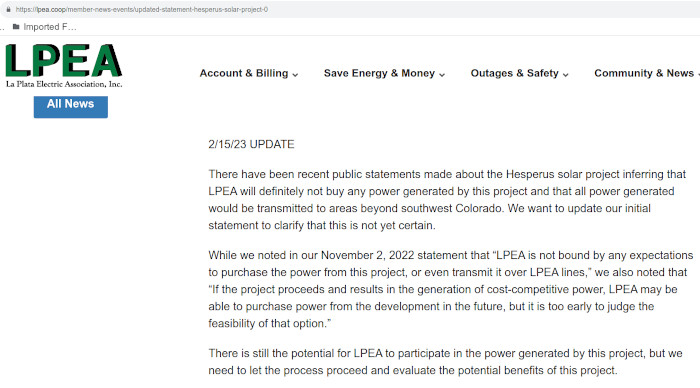
The above response by LPEA was posted on LPEA's website. It is a refutation of the false claim that "LPEA will definitely not buy any power generated by this project".
LPEA's reluctance to publicly define its position is most likely due to the FERC's (Federal Energy Regulatory Commission ) delay in confirming the agreement that allows LPEA to buy 50% of their power from outside sources instead of 5%. Until LPEA gets the OK from the Feds, LPEA can not legally commit to buying power from the Hesperus Solar project. (United Power has been the "monkey wrench wielder".)
Perhaps the best guide to LPEA's intentions was revealed by a sorehead's editorial that was published in the May 7, 2023 edition of the Durango Herald. ("LPEA board dominated by special interests"). The editorial starts out with:
"As a former La Plata Electric Association director, I’ve watched with disgust as the LPEA board has come to be dominated by special interests. As self-declared stewards of the environment, they say they have a “mandate” for local utility scale solar energy."
Water Sources and Rights
Water sources and rights may make or break Primergy's ability to build the solar farm. Primergy has indicated that it intends to bring in hundreds of truck loads of water per day to support the project. If this truck portage system doesn't have some alternative, La Plata county's land use commission may not grant a building permit.
Primergy may be able to get water from an old well on the Three Sisters property, and/or the water rights that belong to the not-currently-used center pivot irrigation system on the Isgar property, and/or may be able to catch enough rain water. Of more importance, a 1912 USGS topo map shows an old irrigation canal that diverted some of the water from the La Plata River onto the area of the planned solar farm.

The topo map above is a portion of the 1912 USGS Red Mesa Topo map. The "Fort Lewis School" is accurately located. The label for Breen (The map places this on the west side of the La Plata River) is not accurate. The current Blue Lake Ranch is at this location. The current community of Breen is just NNE of the 7301 elevation marker near the lower left corner - and on the east side of the La Plata River.
Of interest, there is an old irrigation canal that takes a more southerly route starting just SE of the old Fort Lewis School and continues SSW just to the east of the 7301 elevation marker. This old irrigation canal cuts right thru the "old pivot irrigation system that is not currently used", and is the source of the major green shaded band that runs from the top edge to the bottom edge in the earlier picture. The old irrigation canal is on the Isgar property that is part of the planned Primergy solar project. If the Isgar property still has water rights to this old irrigation system, then the Primergy project probably has a claim on the La Plata River and all the water it could possibly want.
Of even more interest, the La Plata West Water Authority (LPWWA) has recently completed a 3-stage pipeline project that brings Animas River water to the "Dry Side" of La Plata County. 1) Animas River to Lake Nighthorse, 2) Lake Nighthorse to Lake Durango, 3) Lake Durango to Western La Plata County. (Main pipeline is next to highway 141 and continues westward to include Breen. Please see maps at the link.)

The picture above appeared in the April 23, 2023 issue of the Durango Herald. It shows that water from the Animas River is now available for the western half of La Plata County. This includes the area for the proposed Hesperus Solar Project, and Primergy may be able to easily get all the water it might need for the construction of the project. (It is assumed that Primergy will modify its original proposal that planned to haul in water via trucks to instead use this water source.)
And it's not just enough water for the Hesperus Solar Project. It's enough water so that every water faucet in the western half of La Plata County could reliably supply all the water anyone and everyone could want. LPWWA has installed the water pipes to tap into the Animas River and the Hesperus Solar Project could produce the electricity to run the pumps to send Animas River water to anyplace and everyplace in the "Dry Side".
The "Nextdoor" Stop
Hesperus Solar Group
There doesn't seem to be very many members of the "Stop Hesperus Solar" group, but they have been vociferous in their attempts to recruit more support.
(Click on picture for a large version.)
The picture above is a Print Screen image showing the existence of the Stop Hesperus Group on the neighborhood "Stop Hesperus Solar" "Nextdoor" chat group. The Print Screen image has a March 4, 2023 date (See lower right edge in the large version) which is several months after the group's organization. While the group has only 6 members, they have apparently been trying to drum up support for their position. The group's efforts have resulted in several comments on the La Plata County's land use web page.
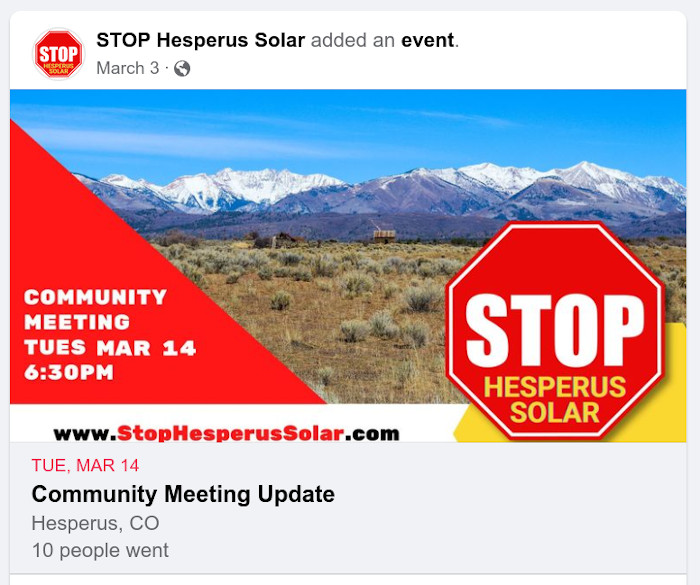
For that matter, a posting on Facebook (https://www.facebook.com/stophesperussolar) indicated there is very little support to stop the project outside of the NIMBYers/obstructionists.
Why are there Solar
Obstructionists?
Why are there Solar Obstructionists? There are probably many answers, but irrational fears are certainly among them. Factual evidence hasn't got a chance when people's irrational fears lead them to deny factual evidence and even fabricate stories that are demonstrably not true. You think I'm joking?
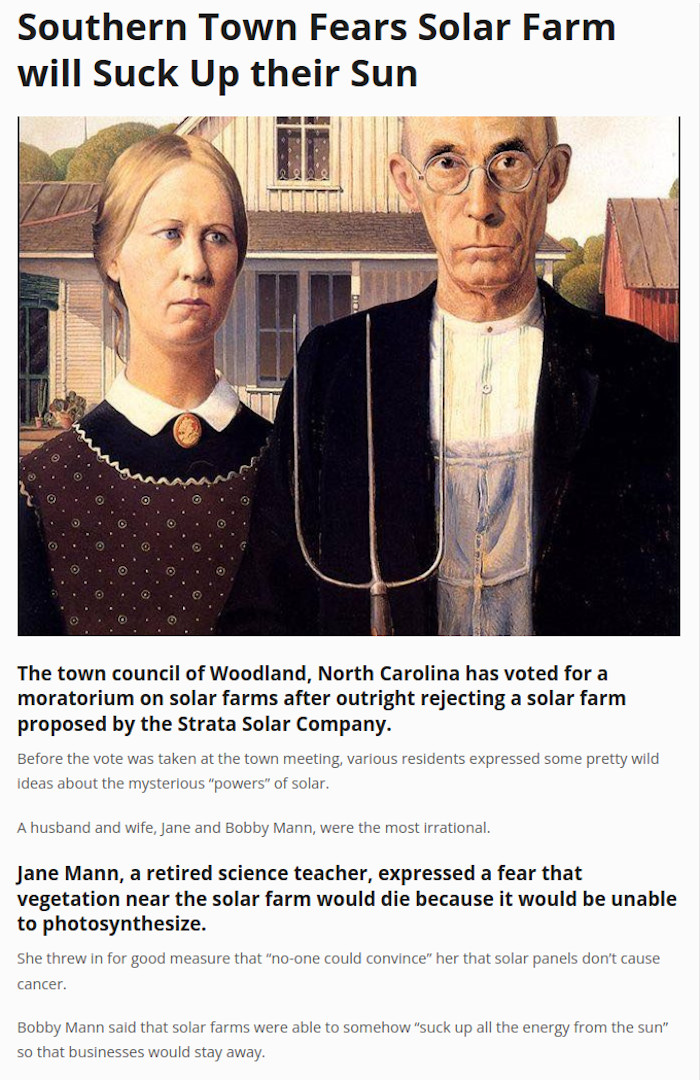
The article "Southern Town Fears Solar Farm will Suck Up their Sun" is real, and the obstructionists did succeed in blocking installation of the solar farm. (Also, please see "NC town rejects solar farm, fearing it would suck up all the energy from the sun" - https://abc11.com/sun-solar-panels-energy/1122081/)
As for the qualifications of the "retired science teacher" . . .

. . .the above cartoon comes to mind.
What you can do to
support the Hesperus Solar project
If you would like to see this project completed, please add your comment to La Plata County's land use web page. Click on " >>>Public Comment Portal<<<" to submit a comment. (Note: The obstructionists are doing everything they can to stop the project - including spreading false information.) A letter to the editor of the Durango Herald would also help.
Cost of electricity by
Energy Source
The cost of electricity production is an important consideration since one way or another this cost is passed on to consumers. The graph below is courtesy of Wikipedia, and gives a general idea of how much it costs to produce electricity depending on the energy source that is used (coal, natural gas, solar, etc.).
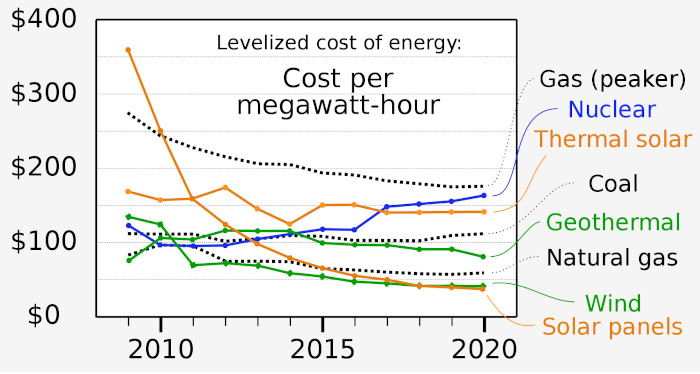
Note: The "Levelized cost of energy" combines operational and other costs with the initial cost to give a total cost per megawatt-hour over the expected life of an installation.
The graph above shows the rough cost of producing electricity using various sources of initial energy - but only if the respective production methods are utilized as much as possible. The "Gas (peaker)" line shows what happens if you use (combined cycle) natural gas only during peak demand hours.
Production methods that require large initial costs for equipment (such as nuclear and solar panels) would have off the top of the graph costs if they were used to supply electricity only during peak demand periods. The least expensive way to produce electricity during peak non solar hours (or non wind hours) is to use combined cycle natural gas. Thus the cheapest 24/7 way to produce electricity would be to use solar as much as possible, and resort to buying combined cycle natural gas electrical generation off the grid when solar isn't available.
A note of major importance should be remembered with solar. The above cost for solar is applicable only when you use utility size solar farms. "The cost of roof top solar will almost double the cost of a solar farm per 1 kilowatt." Roof top solar is more expensive than combined cycle natural gas and thus roof top solar is a poor substitute for older established electrical sources.
Number of solar farms in
the U. S. and the world
For anyone who is interested in the number of solar farms that exist in the United States, as of 2018 according to the U. S. Energy Information Administration there were over 2,500 - and counting. The reason why solar and wind farms are proliferating is that solar and wind are the two least expensive ways to generate electricity. Most people are in favor of reducing their electric bills. (But apparently this does not include the obstructionists.) Also, here is an interactive map of the world's proposed and operating solar farms.
Solar Projects within 60
linear miles of Durango
The following table is a list of solar projects that are in various stages of development (planning, pre-construction, etc.) within 60 linear miles of Durango. Please click on the links for additional information.
Nearby Size Developer
Project Name Community MW Company
------------------------------------------------------------------
Hesperus Solar Hesperus 155 Primergy
Four Corners Solar Farmington 400 Photosol US
San Juan Solar Farmington 598 Photosol US
Rockmont Solar and Storage Kirtland, NM 100 8minute Solar
Clean Path Energy Center Kirtland, NM 70 Western Energy
Shiprock Solar Energy Center Waterflow, NM 372 Photosol US
Boutique Solar Mancos 127 Invenergy
Coyote Gulch Solar Cortez 120 Juwi Inc.
Dolores Canyon Solar Cahone 110 Juwi Inc.
----
2,052 Megawatts
(Project size varies slightly with reference source)
The 3 largest projects will be built be a former subsidiary of the French company Photosol to replace the old coal-fueled generation plant in Waterflow, NM. The old San Juan Generating Station plant in Waterflow produced its last watt of electricity in 2022. If you think the old Navajo Generating Station (coal-fueled) electric plant in Page, AZ will make up the difference, here's an interesting video.
All of Colorado's remaining coal-fired electric generating plants are scheduled for decommissioning no later than 2031. Also, the last of New Mexico's coal-fired electric generating plants is scheduled for retirement by 2031.
It would appear that one way or another, electricity via solar power is coming to Durango. If La Plata county doesn't license/approve the Hesperus Solar project, the land-use tax money, royalties to land owners, probable higher purchase price charged to LPEA, etc. payments will benefit other counties, individuals, etc.
Web page generated via Sea Monkey's Composer HTML editor
within a Linux Cinnamon Mint 20 operating system.
(Goodbye Microsoft)
Return to Durango Bill's home page

